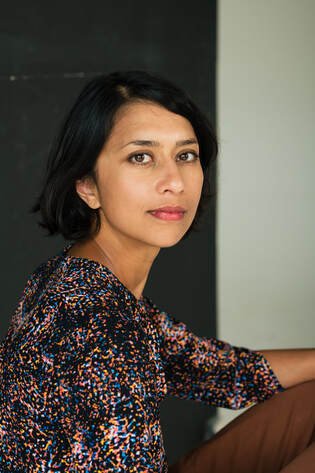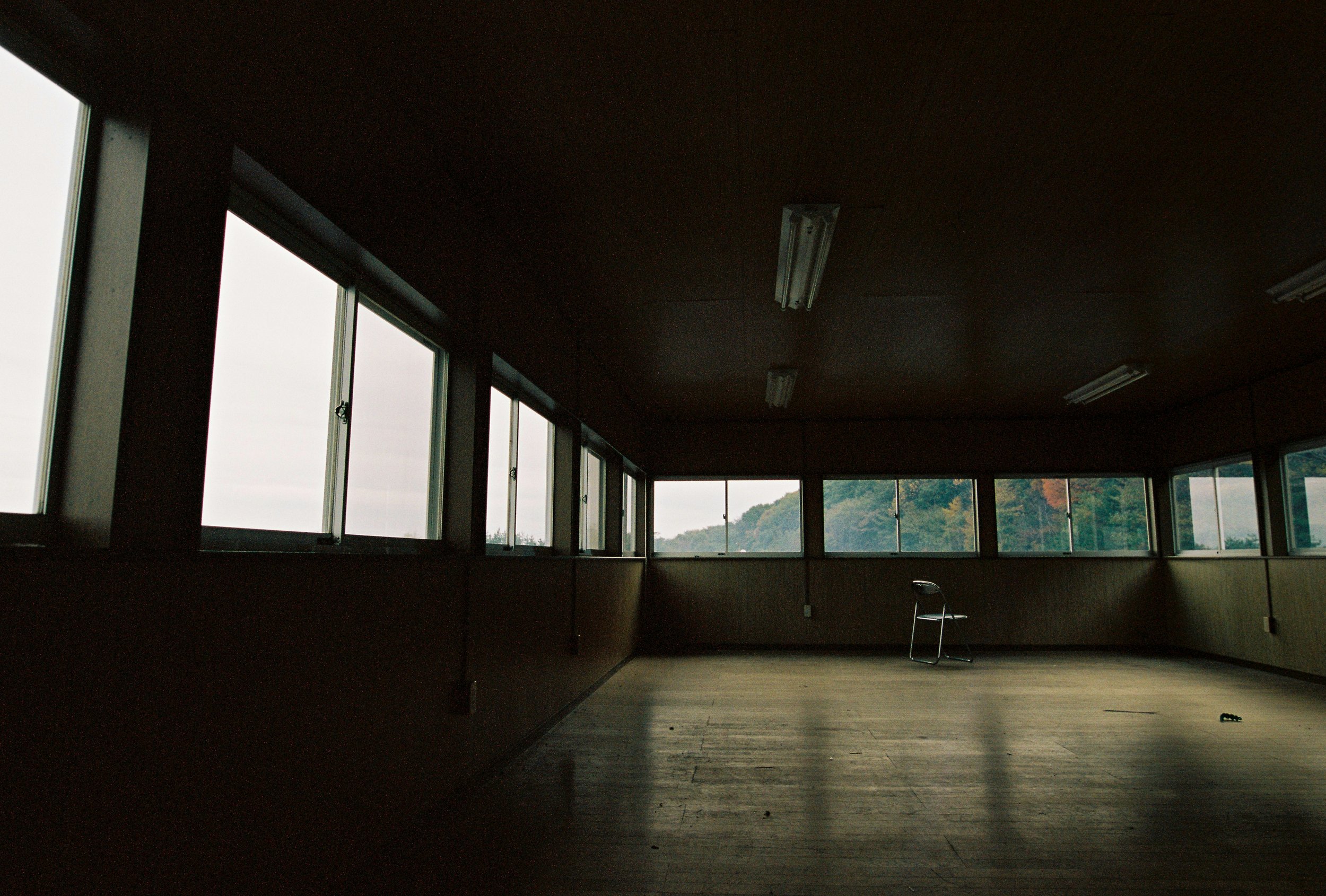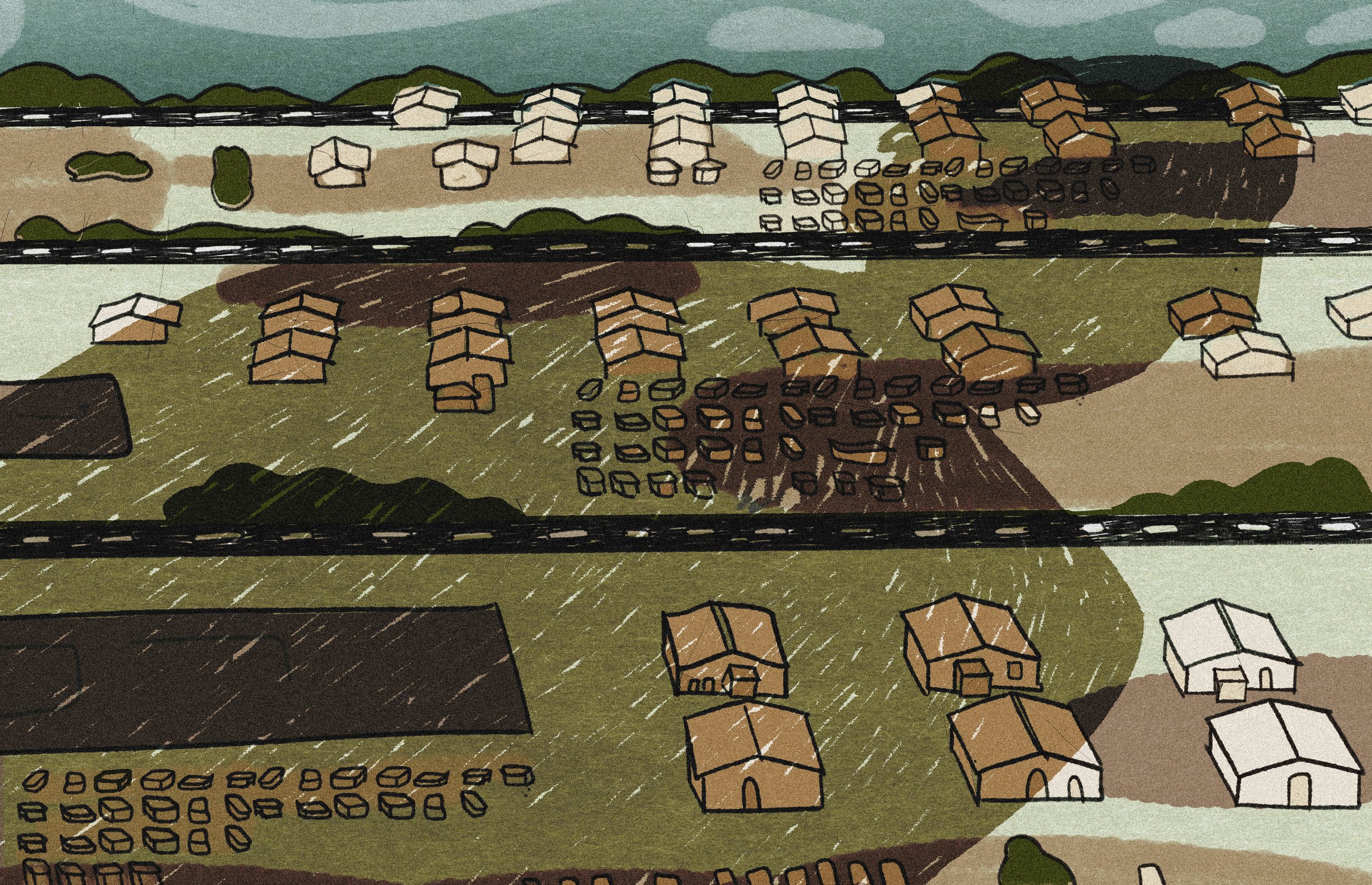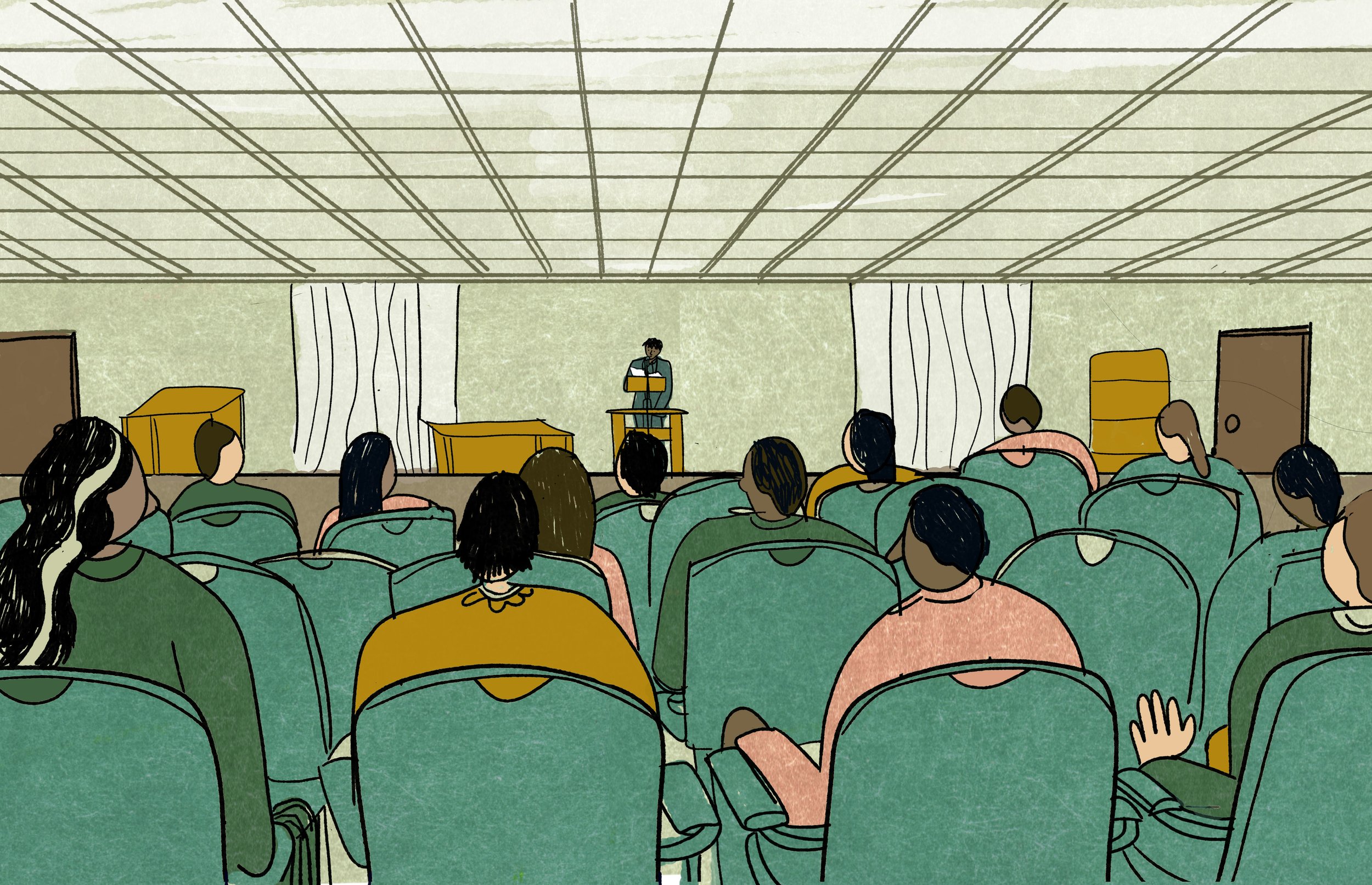Functionally White: What I Didn't Say About Being South Asian in Uganda
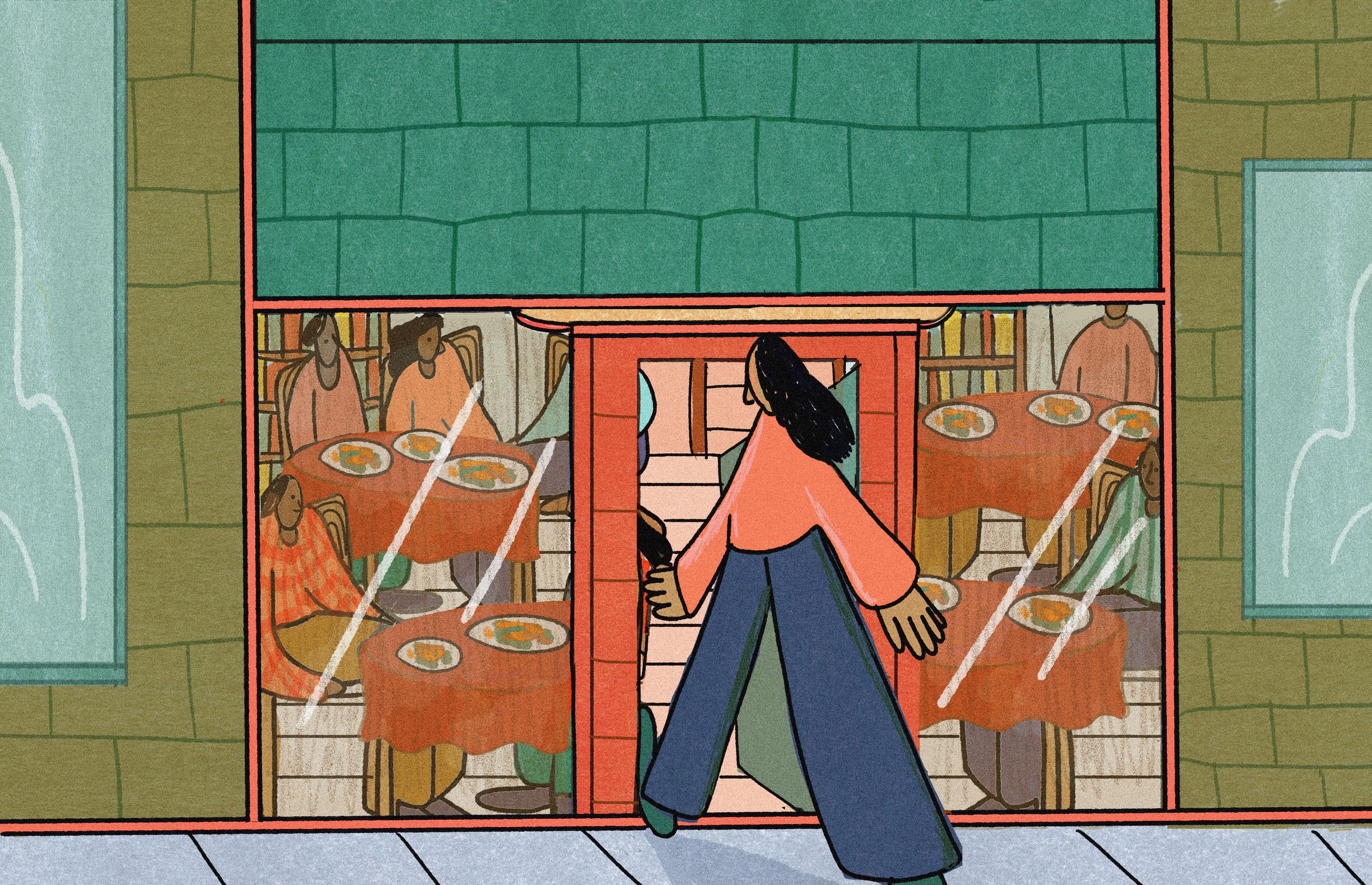
1.
Believe me, I never wanted to go to Masala Chaat House. I passed it every day, a cramped one-room restaurant sandwiched between two printing shops on Kampala's bustling Nasser Road. Through its rain- and dust-streaked windows, I could barely make out the aging wicker chairs and ketchup-colored tablecloths inside. Behind them, DVDs of pirated Mani Ratnam films filled several bookcases. The hot, grease-soaked smell of vadai and samoosa wafted from the entrance. Even without going inside, I found its Indianness oppressive.
Then my boss, Ryan, suggested Masala Chaat House for lunch one day. What could I say: It was too Indian for me, an Indian?
I'd only moved to Uganda two months ago. But it didn't take long to realize Indians were the most visible of minorities here. Adorned brightly in saris and pottus, they descended on Lugogo Oval on weekends, playing cricket and munching fafda. After work, they huddled outside temples and kiranas, expelling long, loud streams of Gujarati into the sweet night air. And every day of the week, they crowded into restaurants like this one for fresh tiffin and even fresher gossip.
When we arrived at Masala Chaat House, forty-something bodies already heated the tiny space like a furnace. “For two?” An older Indian man stood before us. Behind gold-rimmed spectacles, his eyes darted between Ryan and me. In his gathering smirk, I read an assumption of romance—of something necessarily illicit—that enraged me. Being judged by an “uncle” and found immoral—this, too, felt oppressively Indian.
He handed us menus, a dozen laminated pages grouped into south and north Indian, meat-based and vegetarian. I ordered in English but pronounced the dishes as an Indian would, softening my “d’s” and rolling my “r’s.” It had been years since I’d spoken Tamil with any fluency, but my tongue still knew its old grooves.
Around us, diners chatted in English, Luganda, Gujarati. A typical restaurant scene, except for the segregation: Black Ugandans at some tables, south Asians at others. This didn’t strike me as unnatural at first. Mohindis—people of South Asian descent in East Africa—generally kept to themselves. But soon, I noticed requests that crossed color lines—to pass a glass or a shaker of salt—were made and fulfilled in clipped voices. A Black diner thumped a stack of napkins down, avoiding the gaze of the mohindis who’d asked for them. The air at that table—jovial just moments ago—curdled. Ryan and I traded glances. In a country obsessed with social graces, such slights were not slight at all.
At the table behind us, a mohindi man placed his order. He spoke slowly to the Black waiter, his words edging out like molasses. When he was done, he said, “You repeat the order back to me.” The waiter’s cheeks flushed dark red, but he complied. I looked away, ashamed to share a race with this customer.
Above us, clear plastic bags of papadum were crammed into glass cabinets. If their doors burst, would we be buried alive by papadum, I wondered idly. In that moment, it didn’t seem like a bad way to go.
Finally, our meal arrived: uttapaim, idli, sambar, three chutneys—and yes, papadum. I breathed deep, savoring the briny smells of urad dal and coconut. Most Indian restaurants in Calgary served only north Indian dishes: butter chicken, garlic naan, paneer. But this food—this was the food of my childhood, the food of Chennai, home-cooked by aunties with dotted foreheads and saris who cooked more than they could possibly finish and somehow finished it anyway.
I ate slowly, then with growing appetite. The oily puri stained my lips, my fingertips, even my hair. When we were done, we ordered dessert from the stack of milk sweets sweating behind a glass counter. They were dry, crumbling in my mouth, but I devoured them anyway, tasting not just the burfi but the past and its sweetness, too.
For weeks afterwards, I thought about that meal and all that accompanied it. Masala Chaat House was a place of profound hospitality and hostility, which seemed totally at odds with each other. How could they coexist? The only way to arrive at answers, I decided, would be to excavate what I'd witnessed: the vague and festering tensions between mohindis and Black Ugandans, the shifting asymmetries of power between diners and staff, and my own tenuous and confused connections to all of it.
2.
It was 2014, and a particular sort of travel writing was in vogue: Anthony Bourdain topped bestseller lists with his sensuous narratives of food and culinary culture; Nicholas Kristof wrote popular dispatches from the developing world in his New York Times column. I was a new writer then, scared to write without a template. I penned a syrupy ode to “rediscovering the foods of my south Asian childhood” in east Africa. I described Rolexes, a sort of chapati-based burrito, and Masala Chaat House, stacking sensory detail after sensory detail into a soaring, superficial tower of 503 words. Roads & Kingdoms—in which Bourdain was an investor and editor-at-large—published it. My first real byline. I was thrilled.
Now, I find it almost impossible to re-read. Clichés like “sunrise-colored mangos” and “dishes…that almost brought tears to my eyes” are regrettable. But what I really regret is all I left out: that my nostalgia surprised and confused me. That I felt both stifled by the familiarity of Masala Chaat House and enlarged by it. That the tensions partitioning that room were knotted with old pain and entangled with my own history as a south Asian immigrant.
Ultimately, finding “the foods of my childhood” meant little without tracing these migratory pasts, the communities they remade on both sides of the Indian Ocean, and how all those histories shaped that room, that food, and its strange assemblage of people—none stranger, perhaps, than myself.
Before moving to Kampala, I’d traveled to Toronto to meet the principal investor of the start-up I was joining in Uganda. Amir, the researcher I was replacing at the company, was also there for a debrief. After work, we got coffees, sipping them on a bench in a nearby park.
Amir was my age, 23, with short, tousled hair and a hooked nose. He was immediately, intensely curious, asking about my early years in Chennai and my later ones in Calgary, about my last job and my dream job. But when the conversation turned to Uganda, he looked away, breaking eye contact for the first time since we’d sat down. I ignored this and pressed on. What was it like, I asked: the team I’d be joining, the country I was moving to, the people I’d meet there. He answered, in order: fine, beautiful, not so great. He clarified: “Not so great for people like us.”
I waited. It was clear there was more to say. Around us, skyscrapers shimmered in the violet gloam of dusk. He sighed. “Just look up south Asians in Uganda,” he said. “You should be prepared.”
That night, I sprawled in bed with my laptop, googling. For centuries, south Asians had crossed the Indian Ocean, with Gujarati and Tamil traders settling along the Kenyan and Tanzanian coasts as early as 1830. This stream of migrants swelled further in 1896, when the British brought 30,000 Indian laborers to Uganda to build a railway. They encouraged even more to resettle there over the next 70 years, believing Indians, as historian Jan Jelmert Jøgensen wrote, could act as a “buffer in the middle rungs of commerce and administration” between themselves and natives. In government, the British appointed mohindis as bwanas, or managers, to supervise junior African staff. When they established a Ugandan Legislative Council in 1921, they gave Indians a seat but not Africans. In commerce, they welcomed Indians to establish dukas and supply chains all along the train route. From the coast to Lake Victoria, mohindis soon made good money selling sugar, fruit, and palm oil to Black Africans. But this commercial success sowed the seeds of later trouble.
“As a mercantile class dealing with African peasants, often as the representative of foreign capital, they played an all too conspicuous role in the local economy,” writes political economist James Mittelman in his 1975 book “Ideology and Politics in Uganda.” “When Africans were faced with falling prices for their crops or rising costs in the towns, the agents who they confronted were the Asian middlemen.” Mohindis were pawns in a larger game, but they were not altogether unwitting, embracing their superior positions in the government and economy. To make things worse, their traditions of endogamy and caste-based segregation equated dark skin with lower caste and thus, impurity. They avoided Black people, treating them like pariahs—a slur derived from the Tamil "paraiyan," a lower caste group of laborers and servants. “Social contact between Indians and Africans, apart from their brief encounters in shops, is non-existent,” wrote anthropologist Rohit Barot while visiting Kampala in the 1960s for the anthology “Expulsion of a Minority: Essays on Ugandan Asians.” “During my stay there was no single instance of an Indian knowing an African as an equal or a friend.”
In Uganda, this bitterness peaked in 1972 when President Idi Amin expelled all 76,000 south Asians from the country, accusing them of exploiting Uganda’s vast consumer market but refusing to pay their African employees well or offer their African customers fair prices. They were “milking the cow but not feeding it,” he said. Mohindis had 90 days to flee, leaving behind homes, businesses, machinery—everything. They scattered to the UK, Canada, Kenya, India, and Pakistan.
Though thousands of Indians have since returned, they only amount to about 15,000 people, 20% of their size before the expulsion. Despite their shrunken number, they’ve re-established their economic dominance, now owning many of the country’s luxury hotels, manufacturing plants, and banks. A handful of mohindi families control Uganda’s tea and sugar industries, employing tens of thousands of people. Ugandans still complain of mistreatment and low pay at their hands, and of cutthroat competition from even small Indian businesses. Old resentments have bubbled up. In 2007, a protest against the government’s sale of part of a national park to an Indian-owned sugarcane company morphed into an anti-Asian rally. "For one tree cut, five Indians dead," read one poster. Mohindi shops were ransacked and one man killed.
Mohindis believe they are the injured minority: Despite making up less than 1% of the population, they contribute up to 65% of Uganda's tax revenues. In news reports and social media, they claim to do their part for the country. Yet they’re not allowed to vote, nor are they recognized as a distinct group in the census. Getting Ugandan citizenship is difficult for them, despite some calling the country home for generations. But knowing the tides of popular sentiment have rarely flowed in their favor, they aren’t very vocal with their complaints.
Back in Toronto, I stared at my screen, blinking white against the dark. In a few hours, I’d fly to Kampala. That I was learning of this history only now shamed me. I was about to start a job as a research, but what kind of researcher was I? I hadn’t even researched how I was already connected to the place I was moving my life to.
Growing up, I didn’t allow myself to feel any connection to south Asia. When I turned ten, my family left India for Alberta, a western Canadian province of prairie fields, oil wells, and conservative politics. There, in the Texas of Canada, I learned to shrink from my ethnicity. I copied other south Asians who y’all-ed, sported cowboy boots, and ate steak more eagerly than any white person. I devoured books by Jeffrey Eugenides and Sidney Sheldon, but not authors like M.G. Vassanji or V.S. Naipaul, both of whom wrote extensively about the Indian experience in Africa. Nor did I watch movies like “Mississippi Masala,” a 1991 film that follows Sarita Choudhury’s fictional character after she and her family are expelled by Idi Amin. They relocate to Mississippi, where she falls for a young Denzel Washington, outraging both their families. As a teenager in Calgary, I wanted only to copy my white peers: to watch Friends, straighten my hair, and eat mac ‘n cheese.
That night in Toronto, I glimpsed the price of my cultural estrangement for the first time. I was about to move to a country where people like me had a certain reputation. A place where we were ignored at best, and feared or reviled at worst. Not only had I been oblivious to this history until a few hours ago, I still had no idea how to deal with it. No idea of how others had dealt with it before me.
Outside my window, the night was completely dark. My future loneliness pressed down on my chest.
3.
I arrived in Uganda at the start of the dry season, but to me, everything still appeared in bloom. Papaya hung heavy on trees. Jacarandas dazzled in purple, their leaves just starting to wreath the ground. Dew collected on windows and leaves overnight, making the mornings glisten.
In my first week, a colleague introduced me to Sandy, a Black Ugandan woman looking for a housemate. A single mom who managed operations at a construction company, Sandy was brusque and businesslike, used to dealing with rough-edged roofers and bricklayers. But she had softness, too: She loved romance novels, crimson lipstick, and oiling her six-year-old daughter’s hair until it gleamed. I moved in with them into what can only be described as a small, unserviced mansion. We had plenty of space: I had a gigantic bedroom with a balcony from which I could see Lake Victoria, blue and hazy in the distance. But we didn’t have the amenities that typically came with such houses: a guard or a maid, filtered water or wifi. Muyenga, our neighborhood, was home to many expats and upper middle-class Ugandans. There was a wine bar and an Italian supermarket that stocked goat cheese and almond biscotti. But where we lived on Tank Hill Road, at the bottom of a steep hill, felt like a different world. On our street was a stone quarry where men began splitting rock at dawn, and a ramshackle church whose services screamed through the night. I never slept more than a few hours at a time. Still, I was happy there. I didn’t miss the typical expat luxuries; in fact, their absence allowed me to pretend I was living as many Ugandans did. In the beginning, that’s all I wanted.
“I was about to move to a country where people like me had a certain reputation. A place where we were ignored at best, and feared or reviled at worst. Not only had I been oblivious to this history until a few hours ago, I still had no idea how to deal with it. No idea of how others had dealt with it before me.”
My coworkers confirmed Amir had left because he’d tired of “mohindi” spat at him like a slur. Tired, too, of boda drivers speeding past his upturned hand and servers ignoring him. Didn’t matter how much he tipped. And when he traveled upcountry, farmers and duka owners sank into suspicious silence. Some mistook him for a member of the Madhvani or Karmali families—two of the wealthiest in Uganda—muttering obscenities under their breath when he walked by.
For months, I held my breath, waiting for those things to happen to me. Sometimes, a passerby on the street would stare intensely at me, and I tensed, readying myself for the insult. But it never came. I never experienced what Amir did.
Instead of mohindi, Ugandans saw me as something else: mzungu. In Swahili, it means “aimless wanderer.” In Uganda, it typically refers to a white person. “Mzungu” was yelled at me from roadsides and passing bodas and windows, by men and women and elders and kids. It wasn’t meant as an insult. More like a greeting, albeit an abrupt one.
No, it wasn’t an insult. If anything, it was a promotion—a promotion in privilege. Being mzungu meant guards waved me through security and clerks called me to the front of lines. Bodas blew past waiting Ugandans to pick me up first. At restaurants, I got my food before Black diners, even if they’d ordered before me. Mzungu meant deferential smiles, and “you are most welcome” chanted at me the moment I stepped into a market, a shop, a bank. I believed it, too.
Once, I went to a party for an Australian’s birthday. Congolese rumba boomed from the compound. Expat parties happened every weekend in Kampala, but I remember this one because of the guard who opened the gate for me. Most askaris were young, in their teens or early twenties. But this one was a mzee, the folds of his face loose and leathery.
“Hello,” I said. He ducked his head shyly. “They are out back,” he said, addressing the ground. His bald head gleamed under the moonlight. A gesture of respect, I knew—but it was all wrong. Why was this man old enough to be my grandfather lowering his eyes for me? But I knew why.
At work, my company shared an office in Bugolobi with a Ugandan investment firm. Carol, their portfolio manager, was always the first to notice when I had a new outfit. “You’re looking smart!” she’d say. On Fridays, she and I lunched at the nearby market, ordering plates of rice, boiled chicken, and sukuma wiki. Carol wanted to know about Canada: “How cold does it really get?” she asked. “Have you seen the northern lights?” Less often, she asked about India: “Have you been to the Taj Mahal?” A white person asking that would’ve popped the vein in my forehead . But coming from Carol, it felt different. It felt like she wanted to know me, not flatten me.
Carol and Sandy knew I was Indian. But my accent and my coming to Uganda on my own confirmed I was first and foremost a Westerner. (Mohindi women were usually sari-clad, towing a wailing child, poker-faced husband, or aging parent behind them.) I sensed they didn't think I was fully mzungu or fully mohindi. Instead, they saw me as who I was—a body caught between belongings.
But unlike Carol and Sandy, the majority of Ugandans—who I interacted with only briefly, buying mangos at market, or riding on bodas—gave no indication they recognized me as anything other than white. One day, I waited behind a mohindi man to buy bananas at my usual duka. He and Wilson, the duka owner, haggled over the price of cooking oil. After almost ten minutes, the man marched away clutching his bottle of oil, his face blazing with triumph. He’d paid a third less than what Wilson initially quoted. Wilson shook his head at me, amazed. “Those mohindis!” he said, clucking his tongue. “They’re so damn cheap.”
I froze. I looked at him, waiting for him to recognize who he’d spoken to. But his eyes were blank—there was no recognition there. He brightened. “I kept bananas for you,” he said. “Extra sweet this week!”
In those first months, I sometimes wondered why my experience was so different from Amir’s. But I flicked those questions away like flies. I didn’t really want to understand. What I wanted, really, was to live this dream of a life—one where I was constantly waited on, attended to, flattered, befriended, served. Where I was treated as not only important but the most important. What I wanted, really, was to live a white life.
4.
A few months after Ryan and I ate at Masala Chaat House, my laptop froze, its screen flickering an ominous blue. Panicked, I ferried it to an electronics store on Bombo Street, where a mustached Indian man—the owner, I assumed—told me to return the next day. He looked frustrated. “The electricity is out,” he said. “The Blacks in this building never pay their bills on time.” His Black cashier shot him a look, which the owner either didn’t notice or didn’t care to. He was looking at me, his eyebrows raised. You know how it is, his look seemed to say. I grabbed my laptop and fled.
After that, I started spending even more time with expats.
Sandy, my housemate, was busy with family and work. Carol had gotten another job and moved to the north side of town, closer to her sister. But expats had no such obligations. With no family, no history, and no roots here, we clung together, filling the holes in each other’s lives. I started going to trivia night at Bubbles with Ryan and his girlfriend, and to Que Pasa, a pseudo-Mexican restaurant brimming with expats every day of the week. I stopped buying vegetables at the market and started shopping at the air-conditioned supermarket, paying double for tomatoes that were half the size. At least there, I didn’t have to wonder if I was being charged mzungu prices. I knew I was. Somehow, the certainty was comforting.
Historian Noel Ignatiev argues that whiteness is a set of economic and political choices. In How the Irish Became White, he demonstrates how the working-class Irish—initially seen as another unwelcome racial minority in America—pushed Black and brown people out of jobs and neighborhoods in the 19th century. In siding with their white bosses over their Black and brown neighbors, they eventually exploited their way into whiteness.
Amir, it turned out, had refused to play at whiteness. He didn’t frequent Que Pasa or Bubbles, preferring to eat beans and rice at the market stall. He lived in Ntinda, a working-class neighborhood of mohindis and Black Ugandans, and wore second-hand plaid shirts and black rubber shoes with non-slip soles. He didn’t try to cheat Ugandans, but he also refused to pay “mzungu” prices for anything, bargaining to exhaustion. He took matatus, not bodas. He didn’t seek out mohindis but when he saw them, he greeted them in Hindi. In all these ways, he acted little different—economically or politically—from Kampala’s mohindi men. And so he became mohindi, at least in the city’s eyes.
I was starting to understand that race was a different beast here in Uganda. Here, class and politics were factored into racial classifications, rather than existing apart from them. Since most expats bore the markers of the rich Western world—our Birkenstocks, our accents, our safaris—even those of us who weren’t physically white became functionally so. Unless, like Amir, we actively chose otherwise.
“Ultimately, to be white was a moral choice,” writes James Baldwin. Just over a year since moving here, I’d made my choice.
5.
My second year in Uganda, I visited Lake Naivasha, in south-central Kenya. Two friends were there for a long weekend, and I’d catch an overnight bus from Kampala to join them.
We crossed into the Kenyan highlands at sunrise, the hills still webbed with golden mist. By the time we reached Naivasha, the fog had burned off. On the lake’s grassy banks, hippos lolled like giant puppies. I stumbled to my cabin and slept. When I woke, I had a text from my friends. They were at nearby Hell’s Gate National Park. Did I want to join them? Maybe. But first, I needed to eat.
At the lodge restaurant, the men from the cabin next door were eating lunch. I’d seen them when I got off the bus: five mohindi men drinking coffee around a small campfire. They spoke in Punjabi and Swahili, switching easily between the two. Envy pricked me. I couldn’t even speak one mother tongue. It felt unfair—greedy, even—that others had two.
As I pored over the menu, I heard “habari.” One of the men stood by my table. “Nzuri,” I replied automatically.
He switched to English, which irritated me. How could he know from a single word that I wasn’t a native speaker? “Sorry, don’t mean to bother you,” he said. “But we have ordered way more food than we can finish. So we thought, maybe you would like to join us?”
He was the youngest of the group, and nervous, hands shoved deep into his jean pockets. Maybe it was his clear apprehension, the way he spoke as if he expected me to say no, that made me say yes.
The men rushed to add a sixth chair to their table, pushing plates of pakora, ugali, and nyoma choma towards me. They came from the nearby town of Nakuru, they said, where their grandparents had settled in the ‘40s. Four of them owned businesses—a sporting goods store, small supermarkets—and the youngest was finishing high school.
That’s all I got from them before they peppered me with questions: Where was I from? What was I doing here? Did I miss my family? Was I married? Why not? Did I have any East African friends, or were they all foreigners? Had I been to the Masai Mara yet? Ah, that was a shame—did I know it had the world’s best safari? What about the coast—had I been to Mombasa or Malindi? World’s best coast, you know!
“I’d never experienced this type of rejection: rejection from a community I’d always thought I could claim, if only I chose to. ”
“I know,” I said, smiling. I was moved by the pride animating their faces, by how eagerly they thrust photos of Mount Kenya and Mombasa’s white sand beaches at me. As we ate, they gazed out at the lake, drinking in its vast waters, its fringe of dark-ridged volcanoes. One pointed out the red-chested cuckoos flying by the window; another, the papyrus plants sprouting on the lake’s banks.
Though they faced the same tensions and hostilities as mohindis across the region, these men clearly believed they belonged in, and to, Kenya. And vice versa—Kenya belonged to them, too. The country’s most stunning sites, flora, and fauna were part of their heritage, too. For the second time that day, envy struck me. I'd never felt that way, in any place.
My phone buzzed with a text from my friends. They had returned from the park, where was I? I thanked the men for the food and the company, to which they responded “No, no, thank you,” which I found a little odd but didn’t think more about until I saw them again the next evening, stuffing their bags into a small RAV4. They were headed home. We exchanged email addresses and they urged me to visit them in Nakuru one day. I smiled and thanked them, knowing I never would. They piled into the car, except for the youngest one, hands shoved deep into his pockets once more. “Can I ask you something?” His voice was low.
I hesitated. “Sure.”
“How come you were so nice to us?”
I stared at him. “What do you mean?”
“Most mzungus ignore us,” he said. “When we try to be friendly, even just to say hello, they want nothing to do with us. Why is that?”
His question prickled me. Why was he lumping me in with other mzungus? I’d told him yesterday I was born in Chennai.
“I…I don’t know,” I said. “You know I’m not really mzungu, right?”
“Aren’t you?” His face shifted, suddenly looking much older.
For a few seconds, we looked at each other. I felt I’d stepped into a funhouse of distorting mirrors. Had I, in playing the part of mzungu, actually become one? Had I become unrecognizable to my own race? The thought panicked me. For the first time, I’d felt the urge to lay claim to my Indianness, to stake it out like territory I hoped was still mine.
We stared at each other until the car honked, long and loud. He turned away then, folding his long body into the cramped RAV. They all waved goodbye, except him. He looked straight ahead.
Soon, the car was winding its way into the Rift Valley. I watched it shrink against the scrub-clad volcanoes. If not for the ache below my throat, I could almost believe the car and its passengers had never existed. I’d never experienced this type of rejection: rejection from a community I’d always thought I could claim, if only I chose to. I’d believed I was the one turning away from south Asia and south Asians. Now, I saw “my” people may not want me either—that, ultimately, maybe no one would claim me.
I looked up at the sky, wishing it were night. In Calgary, I’d always felt less alone under the stars. But they were nowhere to be seen. Naivasha’s afternoon sky remained devastatingly blue.
6.
After nearly two years in Kampala, most expats I knew had left, replaced by a new set of young white people. I didn't try to get to know them. Trivia night had lost its sheen; margaritas at Que Pasa tasted more watered down. That circle of belonging felt increasingly transient, diluted, dull.
Now, I just wanted to live my life: read, watch pirated films with Sandy, jog up Tank Hill Road until my calves ached. Most days, that was enough. But some days, I wanted more.
I started going to Masala Chaat House almost every week. With its faded storefront sign and napkin dispensers with ‘80s Coca-Cola ads, there was a sense of permanency here that I found comforting. Over time, I got to know the owner and most of the waitstaff, young Black and mohindi men from across the country. I’m still Facebook friends with most of them. Vijay, the owner’s nephew, is always first to like my posts.
The tensions I’d sensed my first time here never disappeared. Mohindi customers still spoke down to Black waitstaff. Diners of different races continued to ignore each other. Still, Masala Chaat House was a space where Black and mohindi Ugandans coexisted—perhaps not in full peace, but maybe that was the price of acknowledging the weight of their history, a history heavy with both beauty and pain. Maybe that’s why I kept going back: the honesty that place required of others, and of myself. Once, a Black diner at the table next to me saw me slurping down my sambar and asked, “Missing home, eh?” What could I say but yes?
“But if Uganda had shown me anything, it was that race was both less and more than skin-deep. ”
Two and a half years after first arriving in Uganda, I left the country in 2016. I’d found another research job in Denver, only a two-hour flight from Calgary. I told everyone my mother had just turned 60 and I wanted to be closer to her. The truth was that I wanted to change my life, the way everyone around me was changing theirs: Sandy was moving in with her new boyfriend; Ryan and his girlfriend were pregnant and moving to the UK. Even George, my favorite boda driver, moved to Kenya to work for a cousin.
In the fall of 2016, I moved into a 600 square foot apartment in Denver that I could barely afford. It was a shock after life in Kampala, its spacious bungalows and leafy gardens, earning dollars and spending shillings. Of course, the biggest change was no longer being mzungu; instead, I was back to being an immigrant, a harrowing status under the new administration. I arrived in Denver just days after the presidential election. People looked shell-shocked, tearing up at Trader Joe’s and Cheesman Park.
In the early days of the Trump presidency, south Asians and Muslims were attacked, one often conflated for the other. If East Africans had a fine-tuned and ever-evolving sense of race, constantly factoring in class and nationality, Americans apparently had no such sense, preferring instead to lump us together into one big brown mass. It would have been funny if it wasn’t also terrifying. Some days, I was nervous to leave my apartment.
The days of being mzungu were truly behind me. I missed them, their freedom and power. But if Uganda had shown me anything, it was that race was both less and more than skin-deep. Our choices and our history mattered, too. Across the country, south Asians joined other minorities in protesting the murder of George Floyd, Trump’s draconian immigration policies, and his re-election campaign. After all those years, I finally saw my Indianness, my brownness, and my nonresident alien status as sources of connection with those I most wanted to know, and to listen to: Black people, Indigenous people, immigrants from Latin America and all the places devastated by American foreign policy.
A few months later, I met Sanjay, the first south Asian I ever dated. Almost immediately, I felt a comfort with him I hadn’t even known was missing in previous relationships. He understood things about my life without me having to explain them. Whether it was my white boss imitating the “Indian head bob” after meeting another south Asian colleague, or the degradation of having my name mispronounced day after day, Sanjay got it. All the small, subjective hurts and joys—he got them. In that way, they felt more real to me, too.
A few months ago, after six years together, we went to Big African Bar and Grill in Lakewood, a Denver suburb. Inside, the walls popped with African masks and tapestries: a camel in the Sahara, a Black woman with a baby on her back. A menu shaped like the African continent. It was so over the top, so clearly satirizing Americans’ expectations of Africa and African cuisine. I loved it.
The Ghanaian owner, Theodore, was boisterous, with mischievous eyes. “I don’t have to explain samoosa to you, eh?” he asked us, winking. We laughed as we were meant to. We ordered fufu, plantain a’lloco, mandazi, samoosas. When our meal arrived, nostalgia engulfed me once more, this time not for India but for Uganda, for all the times I’d eaten a similar meal with Carol at Bugolobi market. This time, I felt I was rediscovering the foods not of my childhood, but of my adulthood—of the place that forced me to grow up like no other.
Across from me, Sanjay smiled. Theodore came by to check on us, and we ordered more samoosas and Club beer. Outside, the sun was setting, lighting up the ochre and red of the trees, turning them incandescent. I’d missed the changing of seasons in Uganda, where months flowed by like a hidden river, uninterrupted and unseen. On this night, time felt stretched out once again, endless and everlasting, a feeling that persisted even after we said goodbye to Theodore, promising him we’d be back, and set out for home.
ABOUT THE AUTHOR
Born in India and raised in Canada, Raksha Vasudevan is a journalist and former aid worker. She has reported on issues of race, environmental justice, housing, and "progress" for The New York Times, VICE, The Guardian, Outside, and High Country News, where she is also a contributing editor. Her essays and commentary on colonial legacy and family estrangement appear in The New York Times Magazine, Harper's Bazaar, Guernica, and others. Her work has been nominated for a Canadian National Magazine Award, two Pushcart Prizes, a Best of the Net award and listed as "Notable" in Best American Essays 2020 and 2021. Raksha has received fellowships and support from Ragdale Foundation, Vermont Studio Center, Virginia Center for the Creative Arts, the Canada Council for the Arts, and the Writers' Trust of Canada. She lives in Denver with her partner and her dog.
Read Raksha’s “Behind the Essay” interview in our newsletter.
Illustrations by Jane Demarest.
Edited by Aube Rey Lescure, with thanks to guest editor Ted Conover.









